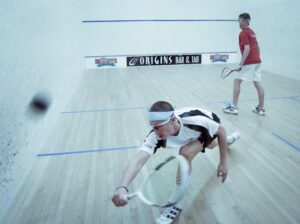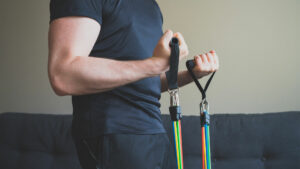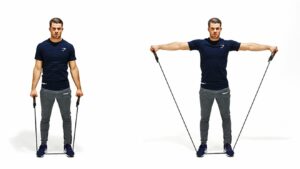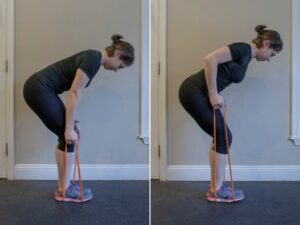When it comes to perfecting the power in arm or leg movements as a Squash player, resistance bands are one exercise tools that are commonly used – especially when it comes to practising drills on a squash court, under the careful watch of your squash coach and even a fitness coach – if you are an elite player.

Different thicknesses and sizes of Resistance Bands
Having the ability to warm up or move freely on the squash court while practising different skills is important for a squash player’s performance, especially when it comes to taking part in a competitive tournament.
As we know weightlifting may not be feasible for younger squash players, as it can actually cause them harm long-term, also older squash players may not get the results they are seeking when implementing outdated methods for strength training – thus resistance bands are the best substitute for improving or gently maintaining muscle mass.
If you are thinking squash players have no need to do resistance band workouts? Then you are wrong as many other types of sports athletes factor resistance band exercises in training sessions as a strategy to improve their explosive power in their chosen sport.
Resistance bands are the one piece of exercise equipment that has been used by army personnel to reduce the physical weight of fighters and help them increase agility, flexibility, explosiveness and endurance, resistance bands are now being used in squash courts and training sessions.
Warning: resistance band exercises are ideal for junior squash players over the age of 12 years, especially those who want to build up confidence before using free weights.
Mastering agility
Resistance training is also good for maintaining muscle mass which can help you become a better squash player.
All Squash players need to know that they must master their agility to improve at the game they have to hit the ball get back to the other side of the court and move with speed; thus this requires a steady amount of strength, power and agility.

Resistance bands are a good workout to perfect lunges
The essential use of this equipment can help squash players develop their agility, explosive power and speed as well as improve balance, reduce chances of injuries and improve movement quality.
Furthermore, squash players who play at an elite standard can gain a massive advantage in their performance on the court by using a resistance band.
If you want to improve forehand speed or foot movement, using a resistance band in training sessions allows you as a squash player to improve by doing a great drill, as a way for developing all-around agile movement by using the resistance band to perform lateral shuffles.
This is a simple way to develop muscular power helping you move in all directions: left, right, forward, backwards and at different angles.
Another important Squash drill, you can do with a resistance band is ghosting – let’s not forget, it is a good way to warm up and get the body moving.
Key exercises for better performance on the court
When it comes to exercise either in the lead-up or post a Squash match, there are some resistance band exercises that should be performed slowly so you can concentrate on proper movement and form.
Some of these exercises are even done and recommended by a fitness coach who specialises in training elite professional athletes, including squash’s racquet cousins – badminton and tennis.
You should complete at least 12 repetitions, whilst using the bands as you increase to between 15-20 repetitions and increase the tension in the resistance band:
Arms Workouts
This workout move primarily targets your biceps, with some forearm activation; which is handy when adding power to your forehand or backhand return. Note, you need to brace your core area throughout and stand with your feet hip-width apart.

Credit: Tom’s Guide
Place the resistance band under your feet and hold a handle in each hand, palms facing up, in an underhand grip. Curl the band up to shoulder height, then lower.
Wrist/Elbow Exercises
Even though ‘Tennis elbow’ commonly occurs in those who play tennis, but happens when you play squash or racquetball too – as a result of overuse of the wrist and the elbow joints.
Video credit: Just Start Fitness
To prevent this, use a resistance band to do this exercise, begin by sitting in a chair and loop a resistance band around your right thigh. Take the right forearm and place it on your thigh and grab the ends of the band with your palm facing up.
Slowly curl your right hand in an upward and downward motion. This will work the forearm muscles. Repeat at least 10 to 12 times before repeating on the other side.
Shoulder Exercises
The arm over/under resistance band exercise will help to improve flexibility and mobility in your shoulder and prevent problems.

Take a resistance band and hold one end with your right hand. Reach over your right shoulder and take your left hand and reach behind your back to grab the other end of the resistance band. Repeat between 10 to 12 times before switching sides.
Bent over rows
In this exercise, begin by placing the band under one foot and stepping backwards with the other foot.

Then bend over keeping your back flat and stop at a 45-degree angle. Pull the bands up towards your waist keeping your elbows close together, and then squeeze your shoulder blades together when performing rowing motion.
Any of these resistance band exercises for racquet sports should allow your body to be better prepared for the rigours associated with squash whilst preventing injury. You will develop and strengthen the necessary muscle groups so you can do well on the court.
Final Thoughts
By factoring a resistance band workout into your weekly fitness regime – there is no do not you can maintain your muscle tone or even better increase it.
It is advisable, any junior squash players aged under 12, have a Squash coach supervise when incorporating resistance band workouts, either in a pre-match or post-match training sessions; in order to make sure they are using the equipment safely.
As you progress in age and as a squash player, consider using them as the more you practice and use the equipment, you can reap the rewards of improving your forehand/backhand moves on the court.

